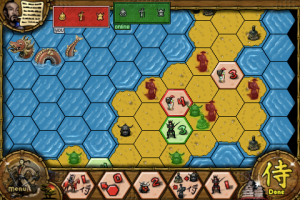Review: Samurai (iPhone)
Posted by James (admin) on September 27th, 2010
 THE GAME
THE GAME
Samurai is a game of tile placement where players try to surround towns and cities with their different strength tiles in order to capture as many of the three different types of tokens as possible. The winner is the player who owns two majorities of the tokens (or has one majority and more other tokens than their opponent). For a description of the game, please read my full review of Samurai the board game as the gameplay of the iPhone game is exactly the same (as you would hope).
OPINION: GAMEPLAY
The gameplay is exactly the same as the board game. Again, the full review of Samurai the board game has more detail about what the game is like. Overall though, Samurai is a very good tactical, tile-placement game.
OPINION: IMPLEMENTATION
The real gameboard is large especially for 4 players (as extra islands are added) so fitting it onto the iPhone is a difficult task. However, this has been accomplished well with a scrollable screen. Scrolling around the map does make it slightly harder/longer to assess your situation, rather than seeing the whole board at once, but that’s just a necessity when playing on a small screen and not a big negative.
The game does allow you to continue a game if you have switched to a different app part-way through a game – a feature I find very important. All 5 of your current tiles are displayed across the bottom of the screen and you simply drag-and-drop them into place where you want to play them, and undoing a move is simple too. The total tokens collected by each player are displayed at the top of the screen.
The AI seems to be good – I’m an average player when I’ve played the board game so I don’t think I’m pressing it too hard but I win as many as I lose. It’s a shame there’s not a difficulty setting though.
Players can play hot seat (multiple human players on the same device passing it around) and this is handled nicely with a screen telling you to pass the device so that you don’t accidentally see any other player’s hand of tiles. Plus, there is online play which is excellent. Board games really lend themselves to being played turn-based online without players needing to be online at the same time. Samurai accomplishes this with a very slick system of game creation and lobbies (where players can join games others have created and are awaiting opponents). The system is simple but very effective – the game displays a message on your iPhone when it is your turn in any of your games and there is even a chat facility for players in a game. When starting an online game, you specify the maximum duration that each opponent is allowed to take before they make their move (from 5 minutes to 3 days). If a player has not made their move within that timescale, you can choose to have the AI take their turn for them. This is a really good solution to the problem of players dropping out of a game.
Samurai on iPhone is a faithful conversion of the board game and one of the best converted I’ve played so far due to its simplicity and polish. The only thing it lacks is some form of progression. I know the board game doesn’t have progression but I always think a digital game offers the chance for new board layouts or challenges that can vary the experience for the solo player like the tournaments in iPhone Ingenious, achievements in iPhone Roll Through the Ages, and challenge mode in iPhone Carcassonne. However, this isn’t a negative for Samurai but more just a missed opportunity.
For £2.99, Samurai is an excellent iPhone board game.
James.
[Played single player with AI players]
Want to purchase Samurai for iPhone?
Use a link below to go to the App Store and 4% of your purchase will go towards maintaining this site (at no extra cost to you).
 |
For iPhone (reviewed) |
 |
For iPad |

